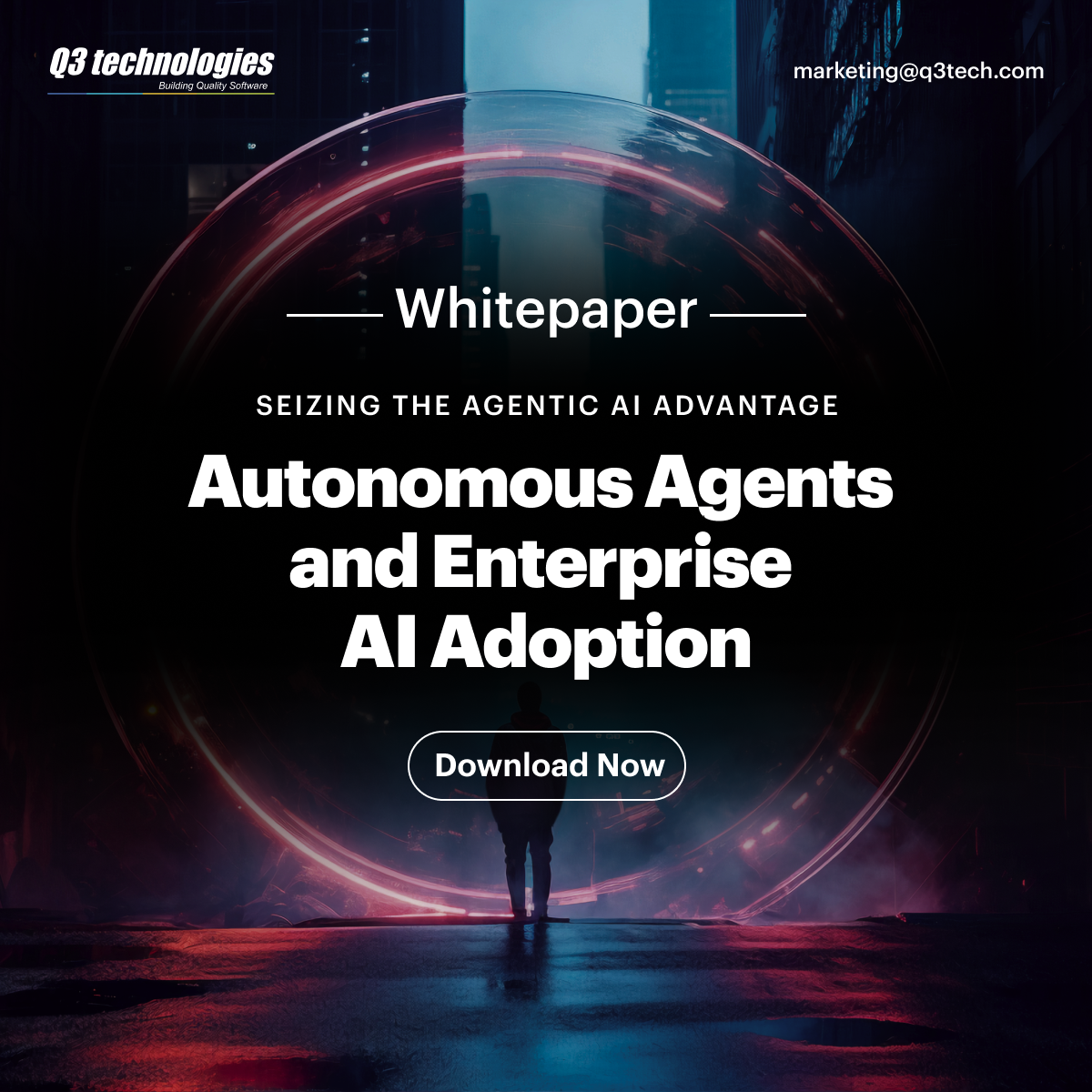Software Development
Exploring Adaptive Software Development: Key Phases and Real-World Applications
 Updated 11 Nov 2025
Updated 11 Nov 2025

Key Takeaways
- Adaptive Software Development (ASD) enables teams to embrace change, improve collaboration, and deliver continuous innovation.
- The three guiding principles—Speculate, Collaborate, and Learn—drive flexibility and learning throughout the development lifecycle.
- ASD’s iterative phases ensure adaptability, faster time-to-market, and improved software quality.
- Real-world applications include adaptive budgeting software, adaptive case management software, and AI-driven ERP systems.
- Custom Software Development plays a key role in building tailored adaptive solutions aligned with business goals.
- ASD enhances enterprise agility, allowing organizations to respond quickly to user feedback and market dynamics.
The digital landscape is evolving faster than ever, and so are customer expectations. Recent surveys indicate that over 78% of businesses have shifted to adaptive software solutions to respond to changing market demands and deliver rapid innovation. Additionally, more than 65% of IT leaders report that their development teams have transitioned to iterative, adaptive models to handle complex enterprise needs efficiently. These figures reflect how flexibility and adaptability have become cornerstones of successful software projects.
This transition marks a significant shift from rigid, plan-driven methodologies toward dynamic, learning-oriented processes. Adaptive software development (ASD) offers a framework that thrives on change rather than resisting it. Unlike traditional methods, it embraces uncertainty, enabling teams to deliver high-quality results through continuous collaboration and iteration. In essence, adaptive development equips organizations with the ability to adjust to evolving technologies, user feedback, and unforeseen challenges—an essential factor for modern digital enterprises.
The Core Philosophy Behind Adaptive Software Development
At its core, adaptive software development is based on three guiding principles—Speculate, Collaborate, and Learn. These principles promote flexibility, teamwork, and ongoing improvement throughout the software lifecycle. Instead of rigidly following predefined steps, ASD encourages developers to speculate about potential outcomes, collaborate effectively to refine those ideas, and learn from each iteration.
- Speculate: Teams make informed assumptions about what the final product should look like, acknowledging that the exact outcome may change as development progresses.
- Collaborate: Continuous interaction among cross-functional teams ensures that ideas are validated, issues are resolved quickly, and feedback is seamlessly incorporated.
- Learn: After each cycle, teams evaluate performance, identify mistakes, and refine their processes to enhance future iterations.
This learning-driven approach fosters innovation and rapid adaptation, which is essential in today’s unpredictable business environment. The goal isn’t perfection in the first attempt—it’s constant improvement based on data and experience.
Build Adaptive Software for Your Business
Partner with Q3 Technologies to create flexible, scalable, and future-ready adaptive software solutions.
Key Phases of Adaptive Software Development
ASD operates through flexible yet structured stages that ensure balance between adaptability and accountability. These phases are iterative and overlapping, designed to accommodate change without compromising quality.
- Speculation Phase: In this phase, the development team outlines high-level goals, features, and deliverables. Rather than setting fixed deadlines or specifications, the team defines adaptive goals that can evolve with project insights. This phase lays the foundation for creativity and flexibility.
- Collaboration Phase: Collaboration is the lifeblood of ASD. It brings together developers, testers, business stakeholders, and customers in a shared communication framework. Open discussions, joint problem-solving, and real-time adjustments ensure that everyone remains aligned as the project evolves.
- Learning Phase: This is where teams analyze outcomes from the previous iterations. Whether a feature performed well or failed, every result contributes to the collective knowledge base. Continuous learning transforms mistakes into valuable lessons that drive progress in subsequent cycles.
For example, in an adaptive software development example, a fintech company might release an early version of its adaptive budgeting software to a small group of users. Feedback collected during this phase helps the team refine user experience, add missing features, and improve performance before the wider launch.
Benefits of Adaptive Software Development for Modern Businesses
The advantages of adaptive software development are far-reaching and particularly relevant in today’s rapidly changing digital ecosystem.

Here’s how it benefits organizations:
- Enhanced Flexibility: ASD allows developers to adjust project goals based on real-time feedback, ensuring that end products meet evolving user demands.
- Faster Time-to-Market: With shorter development cycles, businesses can release updates or new features faster than traditional methods.
- Reduced Risk: Continuous iteration helps identify and fix issues early, lowering the chance of costly post-launch failures.
- Improved Quality: Regular testing and feedback loops ensure that the final software is well-aligned with customer expectations.
- Increased Collaboration: Teams across departments stay connected, fostering a culture of transparency and shared ownership.
- Customer-Centric Outcomes: By integrating user feedback during development, ASD delivers more relevant and user-friendly products.
In a dynamic environment where innovation drives success, these benefits make ASD indispensable for enterprises seeking long-term scalability.
Read Our Case Study: Empowering Transport Services with an Enterprise App Store for a Leading Global Transport Services Provider
Adaptive Software Development vs Traditional Models
Traditional software models, such as the Waterfall approach, emphasize linear stages—requirement gathering, design, implementation, testing, and deployment. While this model works for projects with fixed requirements, it struggles when those requirements evolve midstream.
In contrast, adaptive software development offers:
- Iterative Delivery: Instead of waiting until the end, teams deliver working versions throughout the project.
- Continuous Learning: Teams refine goals and processes after every iteration.
- Responsive Design: ASD can pivot direction easily when customer feedback or market conditions change.
- Collaborative Workflows: Unlike rigid handoffs in traditional models, ASD promotes real-time cooperation across departments.
Thus, while traditional models focus on control and predictability, ASD prioritizes agility, learning, and user alignment—qualities that modern enterprises need to stay competitive.
Accelerate Growth with Adaptive Development
Collaborate with Q3 Technologies to implement agile, data-driven adaptive software for faster innovation.
Real-World Applications and Case Studies
Organizations across industries are leveraging adaptive software solutions to build resilient, customer-focused systems.
- Finance Sector: Banks and fintech firms use adaptive budgeting software to create financial models that evolve with market conditions. These systems automatically adjust forecasts based on spending trends, improving accuracy and strategic decision-making.
- Healthcare Industry: Hospitals implement adaptive case management software to streamline patient data handling. These adaptive platforms enable dynamic workflows that change based on diagnosis, treatment plans, and patient needs—enhancing both efficiency and care quality.
- Manufacturing: Manufacturers integrate ASD into Custom Software Development for production monitoring, predictive maintenance, and workflow automation. By adapting to sensor data in real time, companies reduce downtime and optimize operations.
- Enterprise Resource Planning (ERP): Some forward-thinking organizations combine AI-driven ERP systems future of Nusaker with adaptive methodologies to automate processes, analyze real-time data, and make predictive decisions. These hybrid systems are setting new benchmarks for operational intelligence.
Each of these examples shows how adaptive development empowers companies to deliver better products and experiences through ongoing learning and responsiveness.
The Role of Custom Software Development in Adaptive Environments
Custom Software Development plays a vital role in implementing adaptive methodologies. Off-the-shelf solutions often lack the flexibility needed to evolve with organizational requirements. Custom-built software, on the other hand, allows businesses to tailor features, integrate emerging technologies, and pivot strategies seamlessly.
In adaptive environments, Custom Software Development ensures:
- Alignment with business goals: Achieved through tailored functionalities that directly support organizational objectives.
- Seamless integration: Works effectively with existing IT ecosystems for better efficiency and connectivity.
- Scalability: Enables future business expansions without major reengineering efforts.
- Iterative support: Facilitates updates that reflect changing user needs and market dynamics.
For instance, companies developing adaptive case management software rely on custom frameworks that evolve alongside their internal processes and client expectations. This adaptability helps businesses stay ahead in fast-moving markets.
How Adaptive Software Development Drives Enterprise Agility
Enterprise agility refers to an organization’s ability to respond quickly and efficiently to change. Adaptive software development fosters this agility by creating continuous feedback loops between customers, developers, and stakeholders.
Here’s how ASD enhances enterprise agility:
- Continuous Delivery: Teams deploy updates frequently, ensuring products evolve with market shifts.
- Cross-functional Collaboration: ASD encourages communication across departments, eliminating silos.
- Quick Problem Resolution: Regular iteration cycles enable faster issue detection and resolution.
- Customer-Driven Approach: Businesses can instantly adapt to user insights, ensuring customer satisfaction.
- Data-Backed Decisions: Learning cycles help organizations make informed strategic choices based on evidence, not assumptions.
These factors collectively help businesses reduce time-to-market and enhance operational flexibility—key advantages in competitive industries.
Transform Operations with Smart Software
Leverage Q3 Technologies’ expertise in AI-driven ERP systems and Custom Software Development for real-time agility.
Implementing Adaptive Software Development in Your Organization
Adopting adaptive software development requires a cultural and structural shift within the organization. Here are steps to ensure a successful implementation:
- Educate Teams: Train your workforce on adaptive principles like speculation, collaboration, and learning.
- Start Small: Begin with pilot projects to identify challenges and measure outcomes before scaling.
- Foster Collaboration: Create a work culture where developers, testers, and stakeholders collaborate freely.
- Leverage Tools: Utilize modern project management and feedback tools that support iterative workflows.
- Measure and Learn: Track progress continuously using key performance metrics and apply lessons learned in future cycles.
Organizations that implement ASD successfully often report higher employee engagement, faster delivery cycles, and improved software quality.
The Future of Adaptive Software Solutions
The future of adaptive software solutions looks incredibly promising. With the rapid integration of AI, machine learning, and automation, adaptive frameworks are evolving beyond mere flexibility—they’re becoming intelligent. AI-enhanced adaptive budgeting software can now predict financial trends, while adaptive case management software leverages analytics to optimize case workflows automatically.
Enterprises are also combining Custom Software Development with AI-driven ERP systems future of Nusaker to create adaptive ecosystems that respond in real-time to user behavior and market dynamics. As adaptive technologies mature, we can expect smarter, more autonomous systems capable of self-learning and self-correction.
Ultimately, the next generation of adaptive frameworks will not just respond to change—they will anticipate it, driving unprecedented levels of innovation, efficiency, and business growth.
How Q3 Technologies Empowers Businesses with Adaptive Software Development
Choosing the right partner for adaptive software development can define your project’s success. Q3 Technologies stands out with its deep expertise, agile processes, and client-focused approach that drive innovation and flexibility.
Here’s why businesses choose Q3:
- Custom Software Expertise: Q3 builds tailored adaptive software solutions that align with your business goals and scale as you grow.
- Industry Experience: From finance to healthcare, Q3 delivers specialized tools like adaptive budgeting software and adaptive case management software that solve real-world challenges.
- Agile & Collaborative Approach: Their process mirrors ASD’s “speculate, collaborate, learn” philosophy, ensuring rapid adaptation and continuous improvement.
- Advanced Technology Integration: By combining AI, ML, and AI-driven ERP systems such as the future of Nusaker, Q3 enables smart, data-driven decision-making.
- Reliable Delivery: Q3’s proven track record ensures timely, high-quality outcomes with transparent project management.
In short, Q3 Technologies helps businesses embrace agility and innovation through next-gen adaptive software development, empowering them to stay ahead.
Conclusion
Adaptive software development represents a powerful shift in how businesses approach technology creation. It transforms unpredictability from a threat into an opportunity for learning and improvement. By emphasizing flexibility, collaboration, and continuous learning, ASD enables organizations to stay relevant in a fast-changing digital era.
From finance and healthcare to enterprise automation, the impact of adaptive software solutions is evident across industries. As businesses continue integrating Custom Software Development, adaptive case management software, and adaptive budgeting software, they are not only building better products but also shaping the future of intelligent, responsive enterprises. The adaptive era has arrived—and those who embrace it will lead the way in innovation and agility.
FAQs
How does Adaptive Software Development differ from Agile?
Both focus on flexibility, but adaptive software development goes a step further by embracing change and learning from every phase. Agile follows planned sprints, while adaptive development allows teams to evolve continuously based on feedback and new insights.
What are the key benefits of using Adaptive Software Development?
It helps teams work faster, stay flexible, and reduce risks. Businesses gain better collaboration, improved customer satisfaction, and a product that evolves naturally with market needs.
Can Adaptive Software Development be applied to large-scale projects?
Absolutely. It works well for big projects by dividing them into smaller, manageable cycles. This makes it easier to adapt, track progress, and ensure steady improvement throughout development.
How can organizations implement Adaptive Software Development?
Start small, train teams, encourage open communication, and use collaborative tools. Launch pilot projects first, learn from them, and then scale the approach across departments.
How does Adaptive Software Development improve product quality?
By testing, gathering feedback, and making adjustments at every stage, teams can spot issues early and refine the product continuously. The result is a higher-quality, user-focused solution that keeps getting better over time.
Table of Contents
- The Core Philosophy Behind Adaptive Software Development
- Key Phases of Adaptive Software Development
- Benefits of Adaptive Software Development for Modern Businesses
- Adaptive Software Development vs Traditional Models
- Real-World Applications and Case Studies of Adaptive Software Development
- The Role of Custom Software Development in Adaptive Environments
- How Adaptive Software Development Drives Enterprise Agility
- Implementing Adaptive Software Development in Your Organization
- The Future of Adaptive Software Solutions
- How Q3 Technologies Empowers Businesses with Adaptive Software Development
- FAQs

Explore More

Software Development
AI Tax Software Development: Benefits, Features & Leading Automation Platforms

Software Development
Field Force Management Software Development - A Complete Guide

Software Development